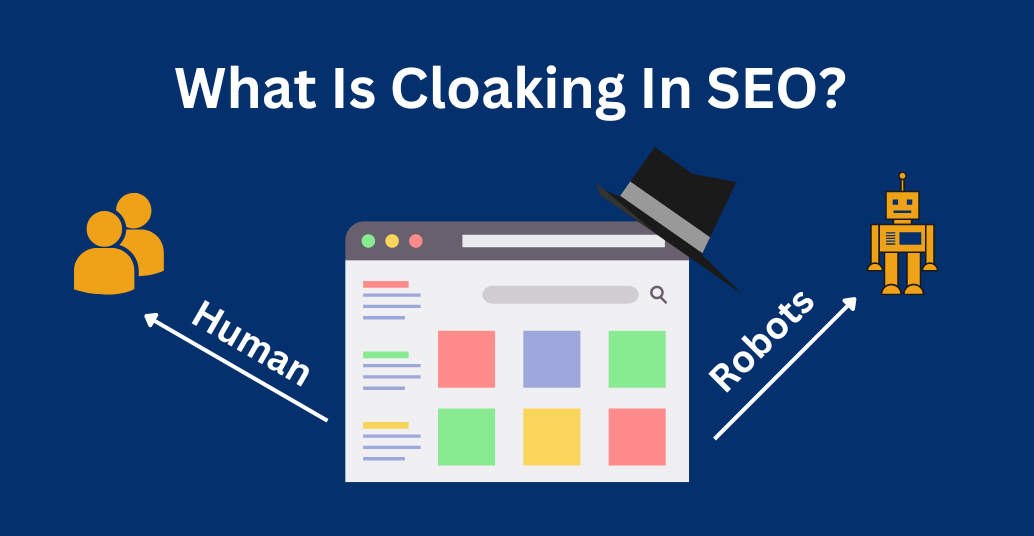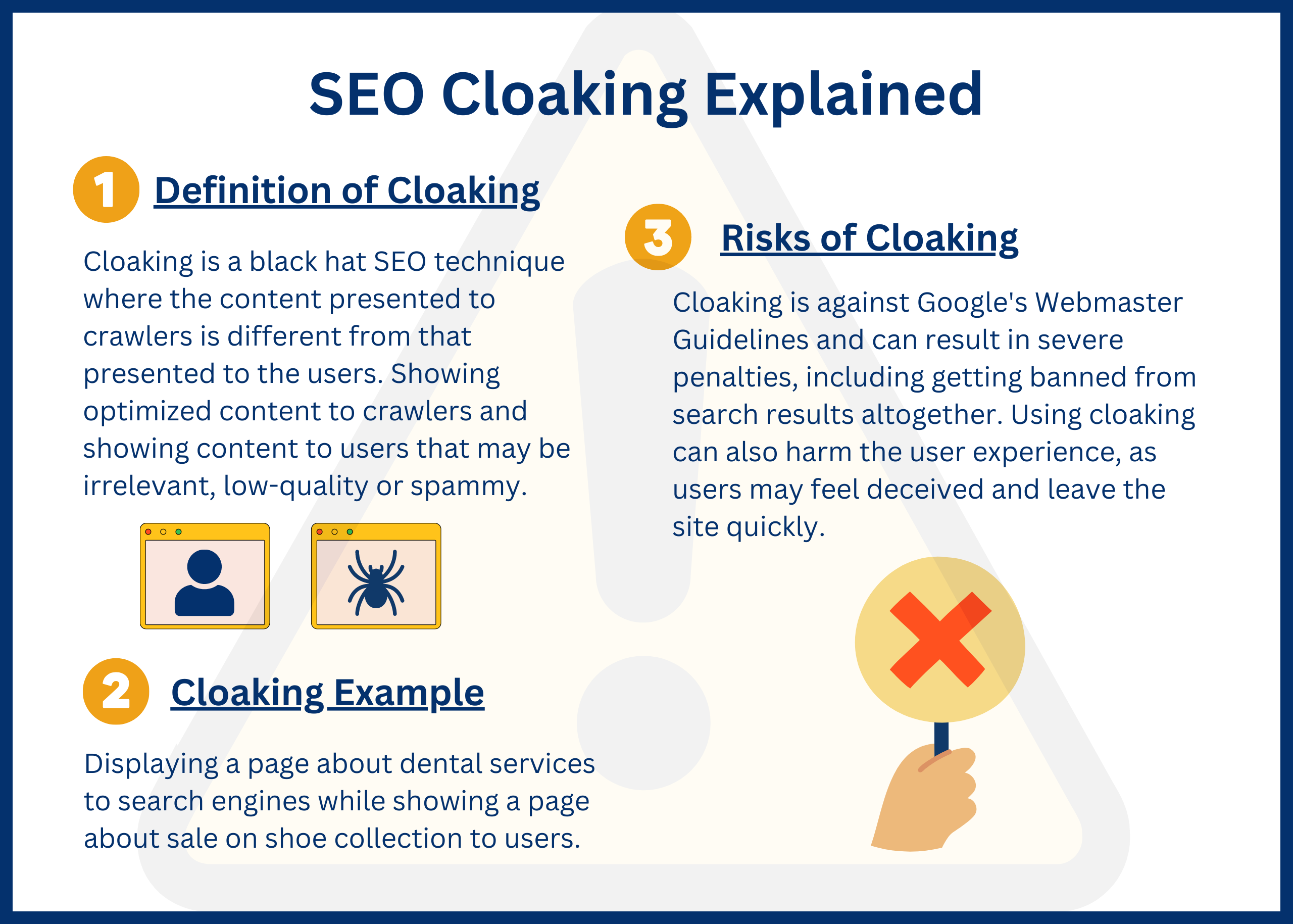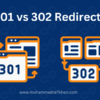
SEO is undoubtedly challenging work, and many brands resort to black-hat tactics to get ahead of the competition. One such technique is cloaking, which involves presenting different content to users and search engines to manipulate rankings.
However, this shortcut to success is harmful to your long-term SEO efforts and can result in penalties or even a ban from search engines. Cloaking violates search engine guidelines and can damage your online reputation. It is a deceptive practice that misleads users and undermines the credibility of your website.
What Is Cloaking in SEO?
Cloaking is one of the basic SEO terms, which means showing different content to users and search engine crawlers.
An example of cloaking is displaying a page about dental services to search engines while showing a page about sale on shoe collection to users.
SEO is undoubtedly challenging work, and many brands resort to black-hat tactics to get ahead of the competition. One such technique is cloaking, which involves presenting different content to users and search engines to manipulate rankings.
However, this shortcut to success is harmful to your long-term SEO efforts and can result in penalties or even a ban from search engines. Cloaking violates search engine guidelines and can damage your online reputation. It is a deceptive practice that misleads users and undermines the credibility of your website.

This technique aims to manipulate search engine rankings and mislead users. The purpose is to improve a website’s search engine rankings for specific keywords. However, cloaking is a black hat SEO technique that violates Google’s spam policies.
Google can issue penalties for cloaking, which can severely impact a website’s rankings, exposure, engagement, and conversion rates. Cloaking can also happen accidentally, so it’s important to understand what it is and why you should avoid it.
That’s why experienced SEO consultant helps businesses to optimize their website and remove any kind of cloaking to maintain a website’s credibility and avoid negative consequences.
What Are The Different Types of Cloaking?
There are five types of cloaking in SEO, and each has its unique approach to presenting different content to search engines and users. Here are some examples:
- IP Cloaking
- User-Agent Cloaking
- JavaScript Cloaking
- HTTP Referrer Cloaking
- HTTP Accept-Language Cloaking
-
IP cloaking
This type of cloaking is based on the user’s IP address. When a user with a specific IP visits a website, they are presented with different content than what a search engine sees when crawling the website. For instance, a website can show content related to a specific region to users with an IP address from that region.
-
User-Agent Cloaking
User-agent cloaking is when a website presents different content to search engines based on their user-agent. User-agents are used by search engines to identify the type of device used to access a website. For example, a website can show a mobile version to users with a mobile user-agent and a desktop version to those with a desktop user-agent.
-
JavaScript Cloaking
JavaScript cloaking involves presenting different content to search engines that do not have JavaScript capabilities. This type of cloaking is becoming less common due to search engines’ ability to crawl and index websites that use JavaScript.
-
HTTP Referrer Cloaking
HTTP Referrer cloaking involves presenting different content to users based on the website they came from. For example, a website can show different content to users coming from a search engine than those coming from a social media platform.
-
HTTP Accept-Language Cloaking
It’s a type of cloaking in which a website detects the language preference of the user’s browser and presents different content to search engine crawlers based on the language setting. For example, if the user’s browser is set to English, the website may show English content to the user, but to search engine crawlers, it may present the same content in a different language, such as Spanish, to improve rankings for Spanish keywords. This type of cloaking is against search engine guidelines and can result in penalties if detected. It’s important to note that all types of cloaking are against search engine guidelines and can result in penalties or even a ban from search engines.
Is Cloaking Good or Bad for SEO?
Cloaking is a manipulative strategy that can harm your website’s long-term SEO efforts and damage your online reputation. Cloaking violates search engine guidelines and can lead to penalties, including removal from search engine results pages.
Cloaking is bad for SEO and should be avoided at all costs. Instead, focus on ethical and sustainable SEO strategies that prioritize delivering high-quality content to both search engines and users. This approach may take longer to yield results, but it will ultimately lead to a more trustworthy and authoritative website that ranks well with high organic traffic.
White Hat Cloaking, A Myth or Reality?
There is often a debate on whether SEO cloaking can be done in a “white hat” way. However, according to Google’s former head of web spam, Matt Cutts, there is no such thing as “white hat” cloaking. Cutts has stated that any form of cloaking, regardless of intent, goes against Google’s guidelines and is not allowed.
Cutts also warns against any attempts to differentiate Googlebot based on user agent or IP address, as this is also considered cloaking by Google. So, it is important to avoid any kind of cloaking technique, as it may lead to penalties or even a ban from search engines.
White hat cloaking is a myth, and any attempts to cloak content from search engines are considered black hat and against Google’s guidelines. It is always best to follow ethical SEO practices and avoid any risky tactics that may harm your website’s reputation and rankings.
Why Should You Avoid Cloaking in SEO?
Here are some reasons why you should avoid cloaking in SEO:
Bad Brand Reputation
Cloaking can damage your brand reputation. When users see irrelevant content, they get frustrated and can assume that your website is misleading. This can lead to a negative perception of your brand and loss of trust. Your website’s reputation matters, and it is not worth damaging it with cloaking.
Penalties from Google
Cloaking violates Google’s Webmaster Guidelines and can result in severe penalties. Google has sophisticated algorithms that can detect cloaking and penalize websites that use it. If Google detects cloaking on your website, it can lower your search engine rankings, remove your website from the search results entirely, or even ban your website from its index. It’s not worth the risk to use cloaking in SEO.
Website Could Disappear
Cloaking can cause your website to disappear entirely from the search results. Search engines aim to provide their users with the most relevant and accurate results. If your website uses cloaking, it can lead to irrelevant and misleading content, which can damage the search engine’s reputation. As a result, search engines can remove your website from their search results entirely.
Cloaking Creates Poor User Experience
Cloaking creates a poor user experience. When users click on a link and see content that is irrelevant or misleading, they will leave the website and go back to the search results. This can increase your bounce rate and lower the time users spend on your website. This can negatively impact your website’s search engine rankings and traffic.
How to Avoid Cloaking
Cloaking is a deceptive SEO practice that can get your website penalized or even banned from search engines. To avoid cloaking, you need to follow some simple steps:
1. Use White Hat SEO Techniques
Instead of trying to deceive search engines, focus on improving your website’s content and user experience. Use legitimate SEO techniques like keyword research, on-page optimization, link building, and content marketing to improve your search engine rankings.
2. Test Your Website with Google’s Tools
Use Google Search Console and Google Analytics to check your website for any cloaking issues. These tools can help you identify any discrepancies between the content you are serving to users and search engines.
3. Avoid IP Detection
Avoid using IP detection techniques to identify search engine bots. Instead, use the user agent string to detect bots. Make sure your website serves the same content to both users and search engines.
4. Don’t Block Search Engines
Make sure your website is accessible to search engine crawlers. Do not block search engine bots from accessing your website’s content.
5. Monitor Your Website
Regularly monitor your website’s search engine rankings and traffic. If you notice any sudden drops in traffic or rankings, investigate the issue to ensure that your website is not cloaking.
By following these simple steps, you can ensure that your website is not cloaking and avoid any penalties from search engines. Remember, the best way to improve your website’s search engine rankings is to focus on creating high-quality content and providing a good user experience.
FAQs about SEO Cloaking
What is cloaking in SEO with an example?
Cloaking in SEO refers to the practice of showing different content to search engine crawlers than what is shown to users.
For example, a website might show search engines content related to a restaurant, while showing users completely unrelated content. This technique is considered a violation of Google’s webmaster guidelines and can result in penalties and a decrease in search engine rankings.
Is cloaking legal in SEO?
No, cloaking is not legal in SEO. It is considered a violation of search engine guidelines and can result in penalties and even disappear your website from google search results.
How does Google detect cloaking?
Google uses various methods to detect cloaking, including analyzing page content, monitoring user behavior, and comparing content served to users and search engine crawlers.





![DoFollow vs. NoFollow Links: Simple & Easy Guide [2023]](https://muhammadrafikhan.com/wp-content/uploads/2023/09/DoFollow-vs.-NoFollow-Links-Simple-Easy-Guide-2023-100x100.png)

